Professional wedding photography.
Getting started in professional wedding photography may overwhelm you, but you have to start somewhere! By reading our guide and gaining an understanding of all things wedding photography, including how to make money doing it, you’ll be off to a great start.
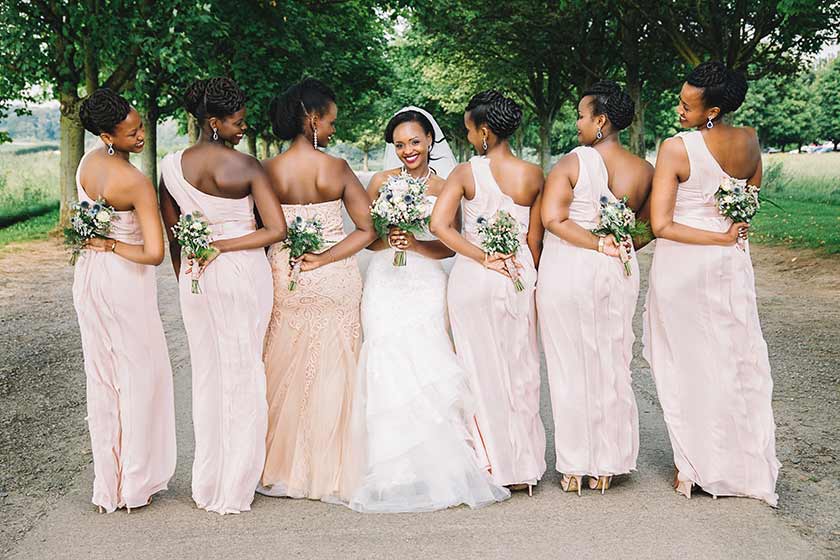
Free Download
Download this wedding shoot equipment checklist to make sure you are prepared for every wedding shoot.
How much do wedding photographers make?
Unfortunately, we have to answer this with “it depends”. A lot of factors go into how wedding photographers price their work. Typically day or hourly rates will be higher than other commissioned work, due to the time spent in addition to photographing the big day. A few things to factor into your quote beyond the actual event are the time spent meeting with the couple in advance, preparing and planning the shoot, renting any equipment, and most importantly, the time spent editing.
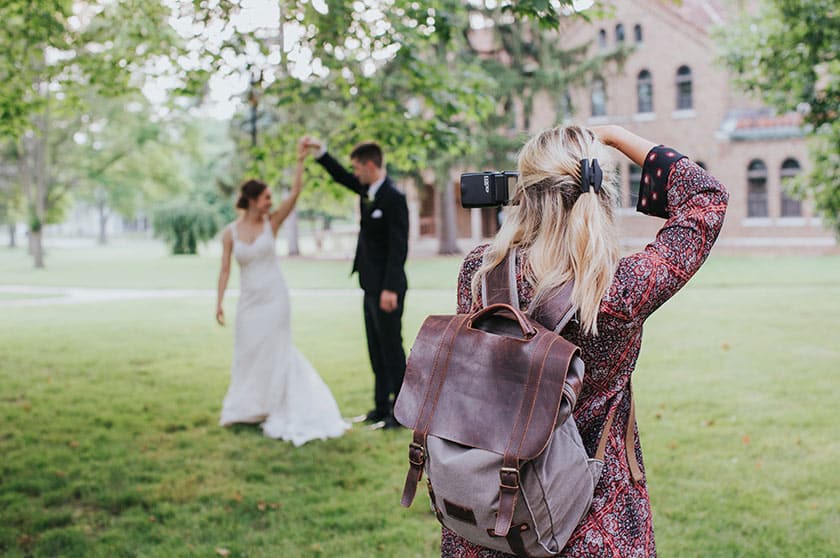
Wedding photographer salary.
A wedding photographer’s salary is totally determined by such things as how much work they take on, the stage they’re at in their career, and the demand there is for wedding photography. Job boards post anywhere from $30,000 – $100,000 for a wedding photographer’s salary, and the average cost of a wedding seems to vary, but can go typically between $2,500 – $7000 give or take. Let’s say you’re doing 15 weddings a year, that’s $37,500 – $105,000. Many wedding photographers seem to take around 25. You can see there’s quite the variance! If you’re augmenting your wedding photography with other work throughout the year, such as engagements, and maternity shoots, you’re doing great! You’ll likely have peak times of being busy, such as the typical ‘wedding season,’ which in many places lasts from late spring to early fall.
Demographic data from survey.
The wedding industry is changing, and it’s good to understand trends and demographic data. There are fewer weddings happening year over year, and the average age of couples has gone up over the years.
Wedding photography equipment.
Having all your gear accounted for and ready to go will alleviate stress and help you succeed. Be sure to have all your lenses in order, and pack a backup camera, batteries, and extra memory cards. Additional accessories that you might consider will depend on your shoot, so consider how a tripod, lighting, and flash accessories may add to the event. Your couple might also love the option of instant film or a photo backdrop!
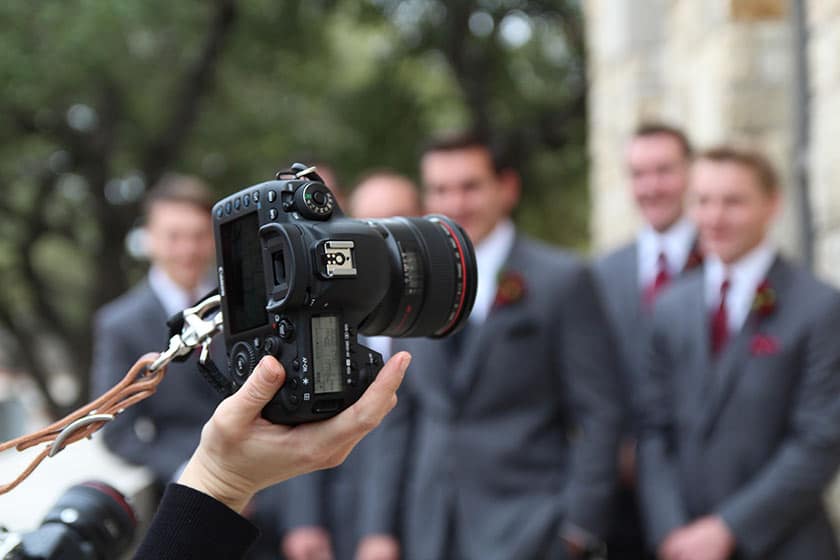
Best lens for wedding photography.
If your budget or existing collection of lenses allows, bring macro, prime, and zoom lenses with you to shoot weddings. Or if you’re just starting out and don’t have the budget to purchase lenses yet, but you really want to impress your clients with your images, consider renting lenses you’re really keen on. Being able to have a variety of shots at various focal lengths will lead to happier clients and a more diverse selection of images. Imagine how happy your couple would be if you were able to capture a detailed shot of the newlyweds’ rings or the unique patterning on the bride’s dress. Now that is icing on top of the cake!
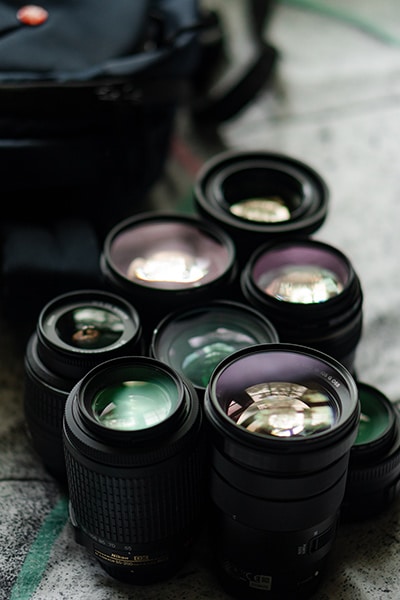
Best cameras for wedding photography.
With all these lenses to contend with, the best bet for cameras first and foremost is to bring two. This way you’re only switching one lens out at a time and have two options always on hand. In terms of the camera body itself, consider a reliable, high-performance option. You’ll want something with good autofocus, something that performs well in low-light situations (high ISO), and one with a high-speed image processor. Consider a mirrorless body with interchangeable lenses, which is generally all of those things, plus it’s lightweight and small, so you’re less weighed down. There are of course great DSLR options still out there, and maybe you’ll want to bring a film camera option too, depending on the couple’s aesthetic.
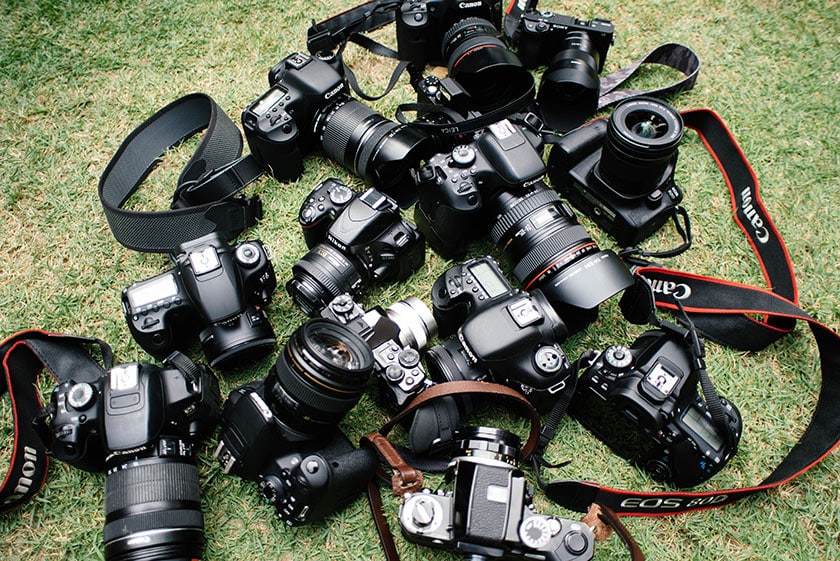
Wedding photography lighting equipment.
If you’re lucky, all you may need for lighting is natural light and a flash. Be sure to know how to utilize the available natural light, because if you have it to work with, it’s arguably the best form of lighting! And the cheapest. Next best bet is a flash, whether that be in areas of low light, or to compensate for backlit subjects or boring, for lack of a better word, natural light. Knowing how to use your flash is key–so be sure to research and practice. There are so many options, from on-camera to off-camera, fill flash, etc.
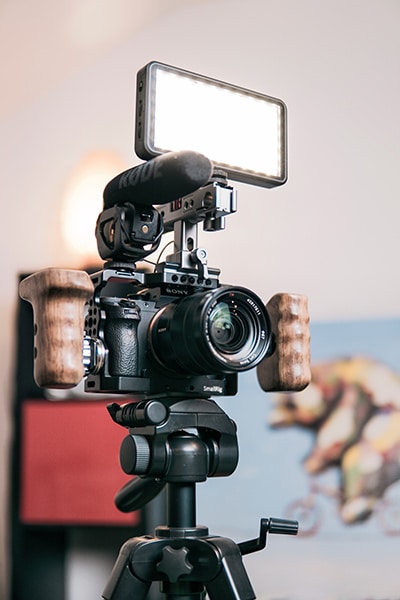
Wedding photography props.
In addition to your camera, lenses, and lighting, you may want to consider wedding photography props. Likely in preliminary conversations with your couple, you’ll talk about a shot list, any inspiration or must-haves the couple has in mind. Something you may want to discuss, or gets brought up by your client, is props. Props can add flair to your shooting, such as a backdrop, atmospheric lighting, or even incorporating a bride’s veil into a shoot in different ways. These add-ons may add time and expense if organized by you, so be sure to factor that in.
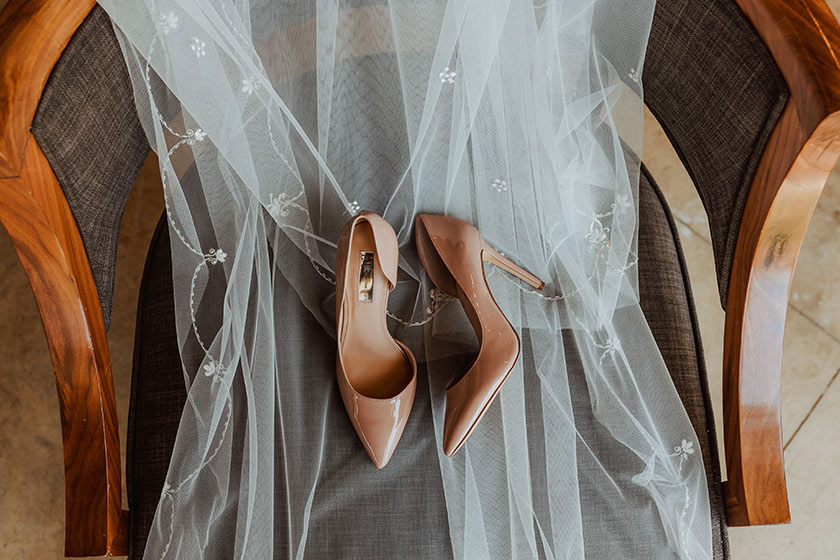
How to get started in wedding photography.
You can enter the field of wedding photography in any number of ways. Some wedding photographers have an education in photography, but many don’t. If you go the route of education, you’ll be provided training, as well as gain a professional network and valuable feedback throughout your education. There are disadvantages to this route, however, which include the cost and time commitment.
Another way of entering wedding photography is by leveraging your existing portfolio and networks. This is a fantastic option if you’ve already established yourself as a photographer. In this case, if you have an existing portfolio, consider creating or adding to your website and promotional mediums that you’re accepting gigs as a wedding photographer.
If you’re just entering the field of photography, consider building your portfolio with complementary shoots, such as offering free engagement or maternity photos. You may even have a close friend who is eloping and trusts you with your style of shooting. Whatever way, you’ll figure it out, just stay open to opportunities.
Here’s a handy checklist for additional tips to get started in wedding photography.
- Gain experience at weddings: Do this by assisting on a shoot. A wedding is a huge moment in someone’s life, and they’ll want an experienced wedding photographer. That’s why it’s a great idea to reach out to wedding photographers to see what opportunities might be available, so you can grow your experience shooting a wedding without having to be the person in charge. Another option is assessing the possibility of taking photos at a wedding you’re attending as a guest, depending on your relationship with the couple. Ask first, do this gracefully, and respect the photographer who has been hired to do it. In fact, it would be best to check if the hired photographer is ok with you also firing off a few frames.
- Promote your skills: if you’re already a photographer, get those skills out there, whether by word of mouth, updating your website, or posting on social media. Promote your experience doing portrait, street, party photography, and anything that could lend itself to showing off your style and what you think a future client might love about your work.
- Lean on your network: whether you’re an established photographer or not, it’s always worth reaching out to friends and family, colleagues, and past clients to let them know you’re building your portfolio or expanding your work. You never know, someone might just take a chance on you.
How to take professional wedding photos
If you’ve gotten to this part of the article, you’ve already done part of the job, from understanding the industry and your potential salary to getting an overview of the equipment you might need and how to get started. Taking great wedding photos has a lot to do with how prepared you are. And for the rest, we’ve got you covered!
- Do your homework: have a good idea of the shot list, understand what your client wants and spend time thinking about your game plan beforehand. Be sure you have the right gear to execute your client’s vision, get a handle on the location prepare for the weather so you’re even more of a pro going in!
- Get a handle on your gear: Your gig might fly by, and moments are just that–moments. So be sure that you can float seamlessly between lenses, switch out gear, and not spend too much time figuring those things out on the spot, as your time, and the wedding party’s, will be precious.
- Be on it: From the small things like the parents of the couple holding hands, to the small details of the wedding decor, keep your eyes peeled. Especially when you’re just starting out, you never know what small moments could be really special and cherished for your client.
Build an online portfolio website you love
Put your wedding photography in the spotlight.
